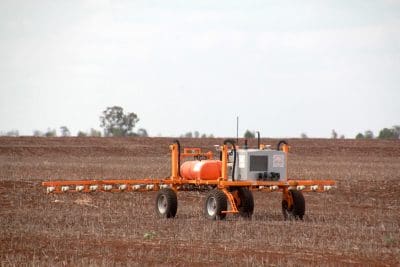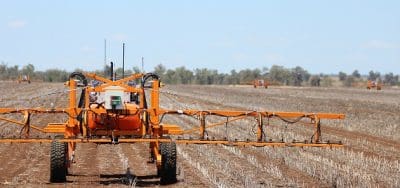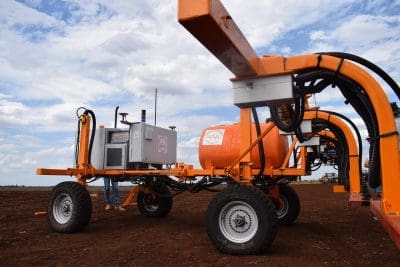SWARMFARM Robotics, the Central Queensland developer of lightweight, driverless robots that perform farming tasks in ‘swarms’, is gearing up for the commercial roll out of its automated machines into key farming sectors throughout Australia next year.

SwarmFarm Robotics is building 50 of its driverless, robotic farming machines for commercial release in 2018.
The Emerald-based enterprise has been developing the robotic platforms over the past six years.
There are currently seven prototype machines that have been used in a comprehensive testing program.
Some of the machines, fitted with eight-metre booms and WEEDit spot spraying systems, were put through their paces in a contracting business fallow spraying in Central Queensland last summer.
Commercialisation
Speaking at an AgForce farm tour of southern Queensland and northern NSW, SwarmFarm founding director and CEO, Andrew Bate, said the project had now reached the commercialisation phase where 50 robots were being built for commercial release in 2018.
“We are starting to roll the machines out next year. We are looking for early adopter customers to come on board,” he said.
“Of the 50 machines, we want to put 10 into grain, 10 into cotton, 10 into sugar, 10 into horticulture and another 10 somewhere in between.”
Mr Bate said every effort was being made to ensure the technology worked effectively and was simple to maintain and operate.
“They will be fully serviced machines. We will maintain them at all levels except daily maintenance, oil changes and tyres. They will be fully warranted for three years. Any failures will be backed by us,” he said.
“They will go out with a monthly fee. That means as improvements come out we will be able to replace those robots with better ones because we know that our systems will improve and get better. It gives us the opportunity to make sure they are completely upgraded and kept up with the latest technology.
“We don’t want legacy robots out there that aren’t the best that can be.”
Mr Bate said SwarmFarm was also embarking on capital raising to bring extra investment into the business.
“We are a team of 11 now. We will grow that to about 30. We need that to make sure we can roll out the support we need for our early customers,” he said.
“We will continue technical development as well. We have a strong engineering team now and will grow it.”
New farming system
Mr Bate said the SwarmFarm concept was not about trying to automate agriculture like with driverless tractors, but was about creating new farming systems and new techniques that couldn’t be done with a tractor.
“We are trying to make farming simple again. We are trying to empower farmers with technology they can use, fix and maintain,” he said.
“(Conventional) machines have become so complicated, so heavy, so large, so many moving parts, so many electronic systems. Ours are little bite-sized, lightweight machines that can do things you can’t do now. They can work 24/7.
“One of the things about robotics that is changing the paradigm of farming is we can actually slow down now. We don’t have to go fast. We just have more little robots instead of one large machine.”
Obstacle detection
Mr Bate said the development team continued to work on the robots and had spent a lot of time on obstacle detection.
“It sounds easy to have a machine that works autonomously in a paddock, but there are washout gullies, contour banks, thick weeds, sticks and rocks. All these things can become obstacles that can stop a machine,” he said.
“An autonomous machine is no good if it stops every 10 minutes because there is a weed or contour bank in front of it. Likewise, it has to be safe and stop when real obstacles are in front of it. Our team has been working on systems to make that technology reliable.”
GPS dropouts
Mr Bate said they had also done a lot of work on GPS-denied navigation with the robots.
“It’s so we can push into horticulture and run between rows beneath trees without GPS coverage. And it’s also for broadacre agriculture where there are spots where the GPS drops out,” he said.
“Effectively a robot is stranded if it loses its RTK GPS. There is no-one there to take over and drive. We have now got the capability to carry on without GPS for quite a time to get through to where there is coverage again. We can maintain the accuracy through that time.”
Whole-farm connectivity
Mr Bate said they were also working on developing communications to ensure whole-farm connectivity.
“In the future when we talk about connectivity, Internet of Things and big data we will get to the stage where, if you haven’t got coverage over the whole farm, it is not the Internet of Things,” he said.
“If five per cent of your farm hasn’t got coverage – whether it’s the pump station or the weather station or a robot working – that will be an issue. Our engineering team is working on some simple-to-deploy comms systems so we can make sure there is coverage all over the farm.”
Simple maintenance
Mr Bate said much of the engineering development work had been focussed on creating machines that were simple to maintain and repair.
“We are trying to change the way people own and maintain their equipment and empower them to fix it themselves,” he said.
“We have a system we have trademarked called Swapnostics where every part of our robots can be changed within 45 minutes.
“That means if an engine blows up you can take the engine module off and replace it within 45 minutes. There are four bolts and a couple of quick-connectors.
“If you have a wiring problem, you can swap the wiring yourself in 45 minutes and get back to work.”




HAVE YOUR SAY